
NGC 2419 is a globular cluster in the constellation Lynx. It was discovered by William Herschel on December 31, 1788. NGC 2419 is at a distance of about 300,000 light years from the Solar System and at the same distance from the Galactic Center.

NGC 1818 is a young globular cluster in the north-west part of the Large Magellanic Cloud, about 3.2 kpc from the center. It was discovered by Scottish astronomer James Dunlop in 1826, and has since been well studied.

NGC 1872 is an open cluster within the Large Magellanic Cloud in the constellation Dorado. It was discovered by James Dunlop in 1826.

NGC 6934 is a globular cluster of stars in the northern constellation of Delphinus, about 52 kilolight-years distant from the Sun. It was discovered by the German-born astronomer William Herschel on 24 September 1785. The cluster is following a highly eccentric orbit through the Milky Way along an orbital plane that is inclined by 73° to the galactic plane. It may share a common dynamic origin with NGC 5466. As of 2018, it has been poorly studied.
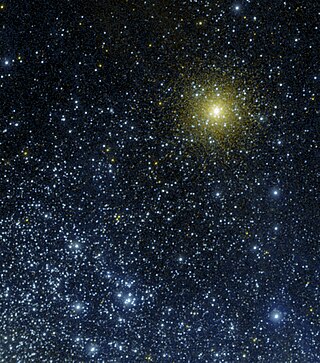
NGC 362 is a globular cluster located in the constellation Tucana in the Southern Hemisphere, slightly north of the Small Magellanic Cloud, to which it is completely unrelated. It was discovered on August 1, 1826, by James Dunlop. It is visible to the naked eye in dark skies, and is an impressive sight in a telescope, although it is somewhat overshadowed by its larger and brighter neighbour 47 Tucanae.
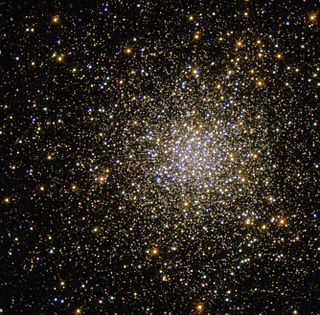
NGC 5694 is a globular cluster in the constellation Hydra. It was discovered in 1784 by William Herschel.

NGC 6304 is a globular cluster in the constellation Ophiuchus. William Herschel discovered this star cluster using an 18.5-inch (47 cm) f/13 speculum reflector telescope in 1786. It is about 19,000 light-years away, near the Milky Way's central bulge.

NGC 6139 is a globular cluster of the Milky Way in the constellation Scorpius. It is located 3.6 kiloparsecs from the Galactic Center.

NGC 1856 is a young, massive star cluster similar to a "blue globular cluster" in the Magellanic Clouds in the constellation Dorado. Its age is estimated to be 80 million years. The object was discovered in 1826 by James Dunlop with a 9-inch reflecting telescope.
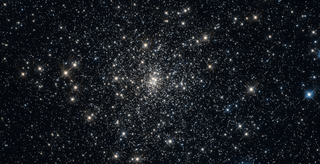
NGC 6256 is a globular cluster of stars in the southern constellation of Scorpius. It was discovered by the Scottish astronomer James Dunlop on Aug 2, 1826. In J. L. E. Dreyer's New General Catalogue annotation it is described as, "very faint, very large, very gradually bright in the middle, well resolved clearly consisting of stars." The cluster is located at a distance of 22 thousand light-years (6.8 kpc) from the Sun.

NGC 6293 is a globular cluster located in the constellation Ophiuchus. Its Shapley–Sawyer Concentration Class is IV. It was discovered by the American astronomer Lewis A. Swift on 8 July 1885. Like many other globular clusters, its distance is not well known; it may be anywhere from 31000 to 52000 light-years away from Earth.
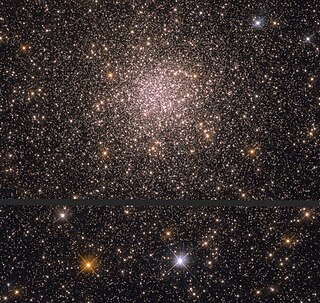
NGC 6316 is a globular cluster located in the constellation Ophiuchus. Its Shapley-Sawyer Concentration Class is III, meaning that it has a "strong inner core of stars" and was discovered by the German-born British astronomer William Herschel on 24 May 1784. It is at a distance of about 37,000 light years away from the Earth. NGC 6316 has a metallicity of -0.45, although new studies suggest this cluster to be more metal Poor, with a metallicity of -0.87 and -0.9; this means that its ratio of hydrogen/helium to other elements is only 35% that of the Sun, but still enough to be considered a "metal-rich" globular cluster.

NGC 6380 is a globular cluster located in the constellation Scorpius. It was originally discovered by James Dunlop in 1826, and he named it Dun 538. Eight years later, in 1834, it was independently rediscovered by John Herschel and he named it H 3688. The cluster was re-rediscovered in 1959 by Paris Pişmiş, who catalogued it as Tonantzintla 1 — and referred to it as Pişmiş 25. Until the 1950s NGC 6380 was thought to be an open cluster. It was A. D. Thackeray who realised that it was in fact a globular cluster. Nowadays, this cluster is reliably recognised in widely available catalogues as a globular cluster, and referred to simply as NGC 6380.
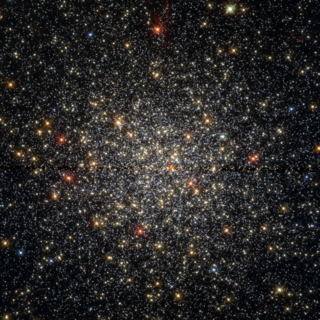
NGC 5927 is a globular cluster in the constellation Lupus. NGC 5927 has a diameter of about 12 arcminutes and an apparent magnitude of +8.86. Its Shapley–Sawyer Concentration Class is VIII, and it contains stars of magnitude 15 and dimmer.
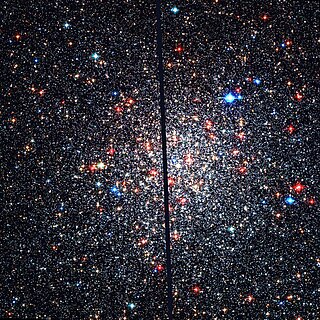
NGC 6553 is a globular cluster in the constellation Sagittarius. NGC 6553 has an apparent magnitude of about 8th magnitude with an apparent diameter of 8.2 arcminutes. Its Shapley–Sawyer Concentration Class is XI, meaning the star concentration is very loose even at the center; it has stars of magnitude 20 and dimmer. It is located just over a degree southeast of Messier 8, the Lagoon Nebula.
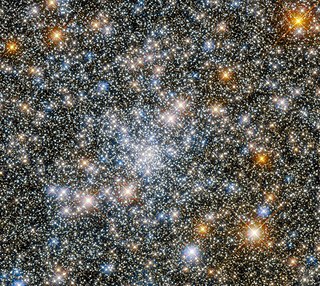
NGC 6540 is a globular cluster of stars in the souther constellation Sagittarius, positioned about 4.66° away from the Galactic Center. It was discovered by German-British astronomer Wilhelm Herschel on May 24, 1784, with an 18.7-inch mirror telescope, who described the cluster as "pretty faint, not large, crookedly extended, easily resolvable". It has an apparent visual magnitude of 9.3 with an angular diameter of about 9.5 arcminutes.

NGC 6528 is a globular cluster in the constellation Sagittarius, and is listed in the New General Catalogue. It has an apparent magnitude of about 11 and a diameter of about 16 arcminutes, and its Shapley-Sawyer Concentration Class is V, containing stars of 16th magnitude and dimmer. Dreyer described it as "pF, cS, R", meaning poor and faint, considerably small and round.

NGC 1898 is a globular cluster in the constellation of Dorado at an approximate distance of 170,000 light-years. NGC 1898 is located in the Large Magellanic Cloud, a satellite galaxy of the Milky Way, and was for some time believed to be discovered by John Herschel in 1834; however recent research shows it was first observed by James Dunlop in 1826.

NGC 1866 is a globular cluster in the Large Magellanic Cloud, located in the constellation of Dorado. NGC 1866 was discovered August 3, 1826 by James Dunlop.

NGC 7492 is a globular cluster in the constellation Aquarius. It was discovered by the astronomer William Herschel on September 20, 1786. It resides in the outskirts of the Milky Way, about 80,000 light-years away, more than twice the distance between the Sun and the center of the galaxy, and is a benchmark member of the outer galactic halo. The cluster is immersed in, but does not kinematically belong to, the Sagittarius Stream.




















